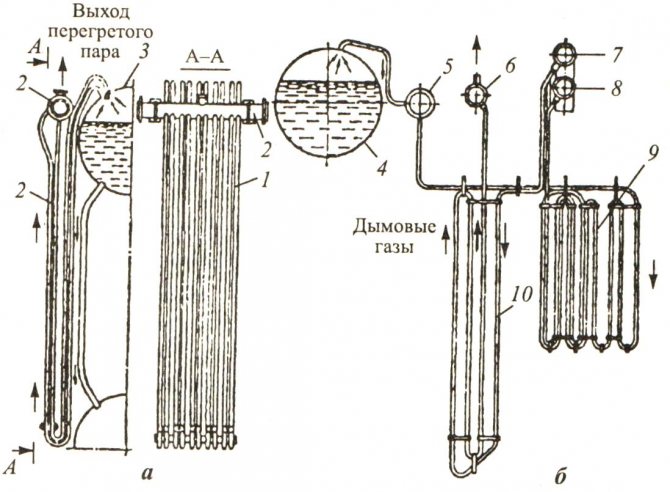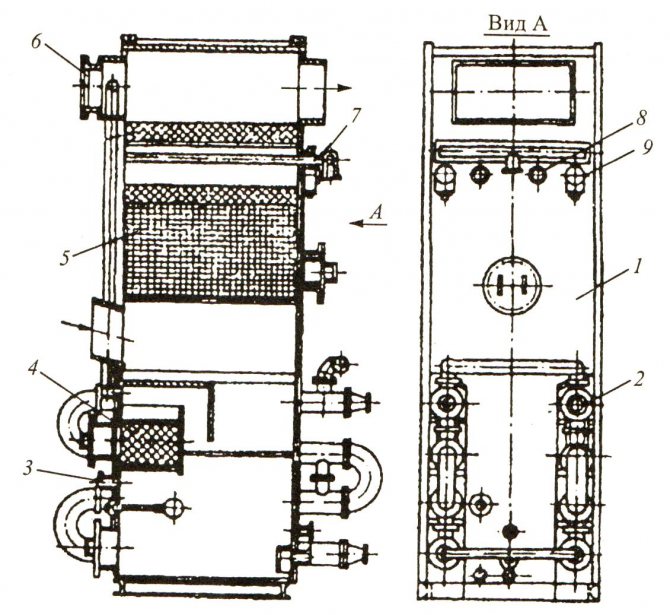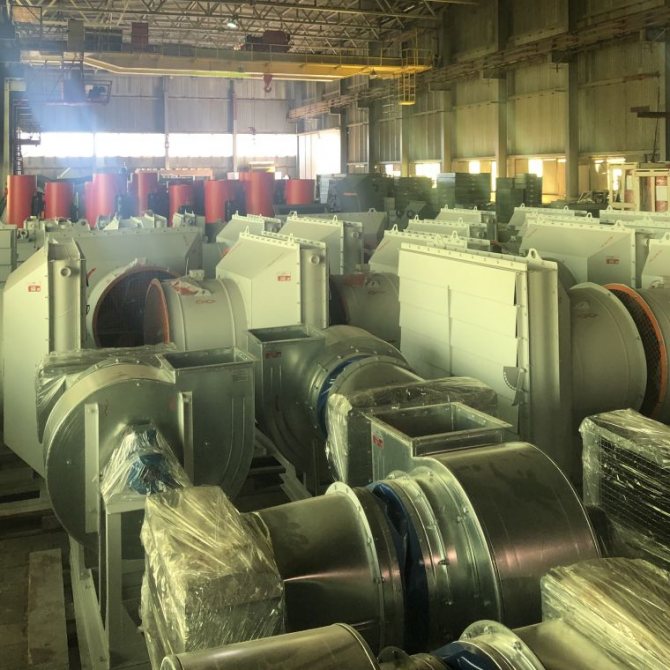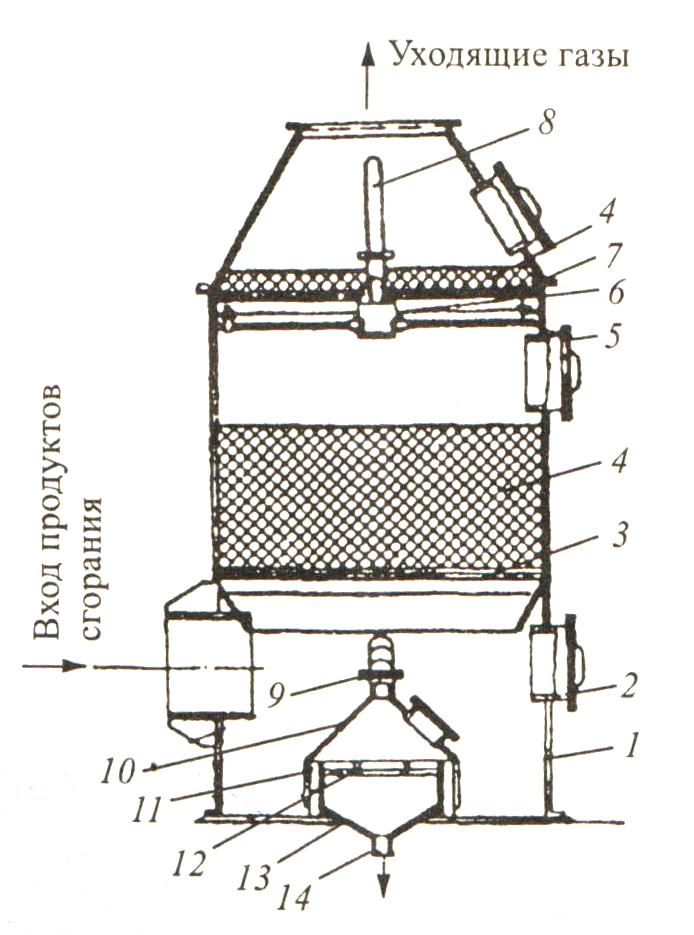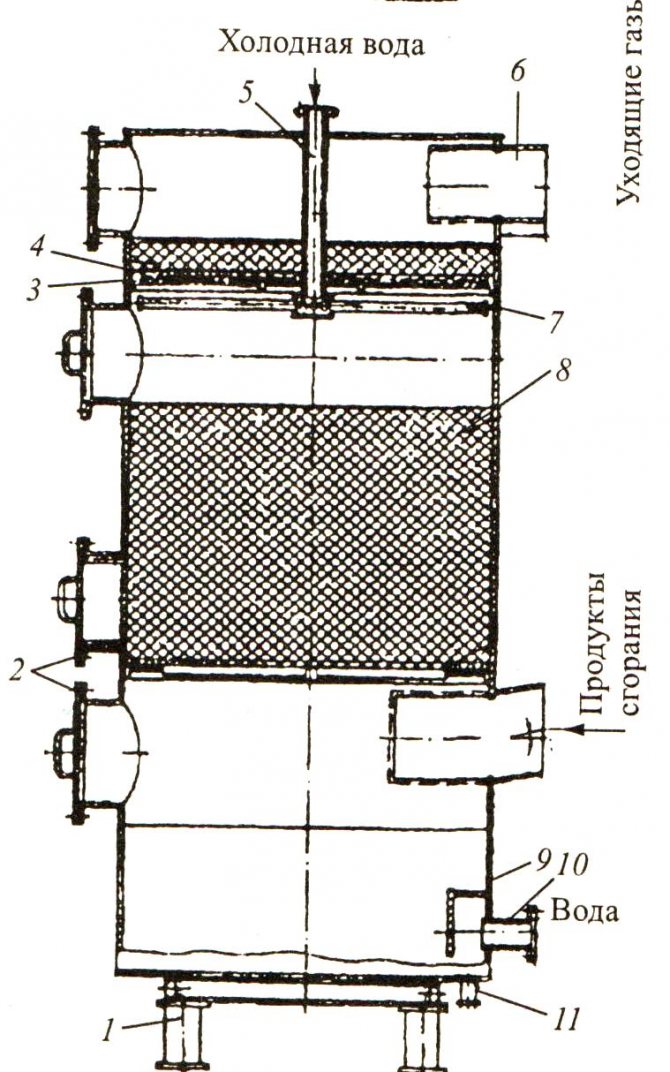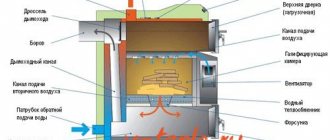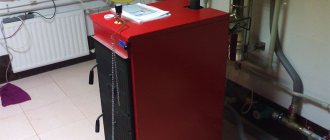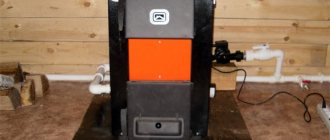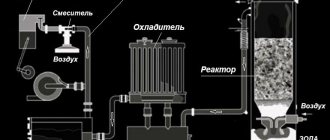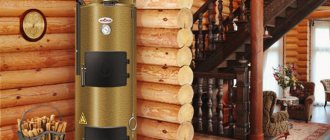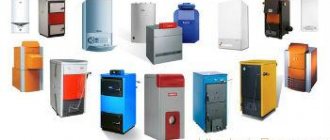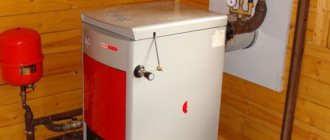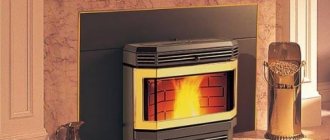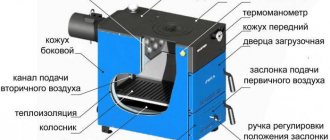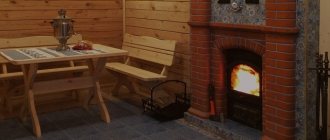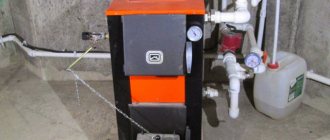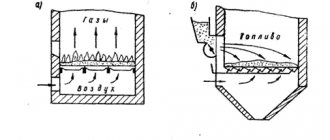Furnace types Engineer
In the Engineer series, there are three basic modifications: a convection wood-burning stove and its counterpart, coal-fired. Particularly noteworthy is the Gidravlik model, which works to heat the coolant and is built into an existing radiator heating system.
Regardless of the type of modification chosen, the furnaces have the following general characteristics:
- Material - furnaces are made of heat-resistant structural steel. To avoid deformation, a blind cast-iron door is installed on the combustion chamber. At the request of the customer, you can choose an Engineer stove with a cast-iron door with glass.
- Furnace steel thickness - combustion chamber and important components are made of structural steel with a wall thickness of at least 5 mm.
- The presence of a surface for cooking - the cooking and heating oven does not have a full-fledged panel for cooking. For this purpose, the upper horizontal surface of the enclosure is used.
- Connection to the chimney - in each model of the Engineer series, modifications with the upper and rear chimney outlet are offered, which greatly facilitates the installation and connection of the stove.
There are technical characteristics inherent exclusively in wood and coal stoves, as well as in the Hydraulic series. Before deciding on the choice, take into account the peculiarities of work and operation, the burning time from one bookmark of firewood.
Wood Burning Engineer
Metal hot water boiler Professor Butakov Engineer is a traditional model of wood-fired stove equipment. The principle of operation is based on the use of natural air convection.
An air heating boiler has the following differences:
- The special design of the combustion chamber - the series is distinguished by a larger volume of the firebox with a capacity of 120 liters.
- Convective channels - volumetric pipes are installed in the design of the furnace, submerged by ⅔ of their size into the furnace.
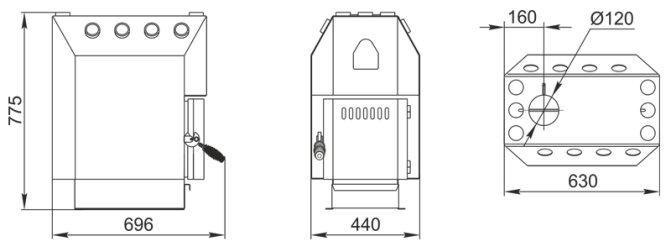
Coal Engineer
Coal heating solid fuel stove Butakov Engineer, is the successor to the basic wood-burning model. Certain changes have been made to provide the necessary conditions for coal combustion:
- The thickness of the furnace walls has been increased.
- Improved air flow into the combustion chamber.
The changes made led to better heat transfer, an increase in the operating time of the furnace from one bookmark to several days. Special mention should be made of the special design of the ash box, which allows removing the accumulated ash without interrupting the combustion.
Heating of the premises is carried out using an air-heating method. Furnace productivity Engineer Coal 16 kW.
Water Hydraulic Engineer
The water heating stove Termofor Engineer Hydraulik is intended for modification of existing heating systems. Performance from 12 to 26 kW, sufficient for comfortable heating of medium-sized buildings, up to 260 m².
In general, a wood-burning heating stove with a water circuit Engineer Gidravlik is a full-fledged solid fuel boiler, convenient in operation and maintenance. The advantage of the series is the built-in unit of tubular electric heaters (TEN). After the flame has died out, the stove continues to heat the coolant using electricity.
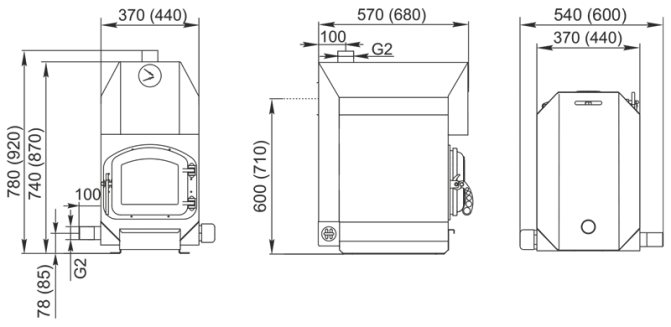

Pricing policy for the oven
The Russian company Termofor focuses on the domestic consumer market of heating equipment. For this reason, all manufactured stoves are offered at an affordable cost.
Several factors affect the price: the type of room heating, the presence of heat-resistant glass for the door, performance.
The average cost per model, depending on the configuration, is as follows:
- Hydraulics - about 30 thousand rubles.
- Wood Engineer - 17 thousand rubles
- Engineer Coal - 22 thousand rubles.
Review of the heating furnace Termofor Professor Butakov Student
“Fire is beating in a cramped stove” ... This well-known line has not lost its relevance today. We still need a stove that heats our home. But the stove of our day is by no means a "cramped" refuge for the flame. Effective, hot, powerful, modern design models are an excellent solution for rooms or houses that require heating.
Today in the market of boilers-heaters the most demanded is the model range of air-heating furnaces Termofor Professor Butakov. One of the most popular among them is the highly efficient independent model Termofor Professor Butakov "Student".
"Student" has modifications - a wood-fired boiler and a coal-fired boiler. Both of them can work on fuel briquettes for closed-type heaters, peat briquettes and pellets.
Purpose and general description
The solid fuel boiler Professor Butakov "Student" is designed for uniform and economical heating of residential, utility and industrial premises with a total volume of up to 150 m3.
Due to its design features - a flat horizontal surface - it has increased functionality and provides a full-fledged cooking opportunity.
For the most convenient installation and assembly, as well as compliance with fire safety standards, the boiler has modifications depending on the design of the chimney outlet. The chimney can be installed vertically in the upper part of the enclosure or on the rear of the enclosure, carrying out horizontal flue exhaust to the rear.
Heating is carried out due to gas generation, which occurs in the furnace as a result of smoldering wood or coal. The smoldering process is the main operating mode of the oven. The normal operating conditions for a solid fuel furnace are an air temperature range of –60 ... + 40 ° C. Hot air is discharged through the openings of the side nozzles located on the sidewalls and the upper plane of the furnace.
The outer surfaces are covered with heat-resistant protective organosilicon enamel KO-868.
The boiler is equipped with a stable base plate with fixing holes for secure fixation to the floor in the heated room.
Design and specifications
The stove "Student" has a modern design and is made of special technical steel up to 3 mm thick.
Inside there are convector pipes that surround the combustion chamber. The upper part of the firebox is equipped with gas guiding screens. The system of convection pipes and gas guiding screens ensures the highest possible heat transfer during fuel combustion and gas removal.
To maintain the combustion (smoldering) process and the flow of additional air into the furnace, there are nozzles bent from the bottom up towards the air flow.
A sealed cast-iron / metal door of the combustion chamber with a light-transmitting screen (or a blind door) is mounted on hinges. The firebox door has a maximum opening angle of 120 ° C. The door locking mechanism fixes it firmly when closed by turning the handle. Reliable fixation ensures complete combustion, heat transfer, and fire safety. A convector panel is mounted on the door, which accelerates the heating of the air in the heated room.
The grates are made in the form of grooves. The grate is located at the bottom of the furnace and promotes forced combustion and the achievement of a high flame temperature at the time of ignition of the furnace. The sealed ash pan can be equipped with an air damper, which additionally regulates the air supply to the firebox.
Combustion products (ash) move through the grate slots into a pull-out ash drawer. The retractable ash pan system provides cleaning of the fuel chamber without stopping the combustion.
The flue channels of the boiler are equipped with a gate for distributing gas supply and for fire safety purposes.
Terms of use and operation
For the initial lighting of the fire and starting the furnace, it is necessary to half-fill the chamber with fuel, light the fire, observing safety measures. Carry out heating for 1 hour, preferably outdoors.
To ignite the boiler, fuel is loaded into the fuel chamber, depending on the modification of the boiler. To ignite and maintain the combustion process, it is necessary to provide access to the primary air through the covered ash pan and grate to the firebox. Secondary combustion air enters through the jets.
To ensure the intensity of the ignition, the ash pan extends. To ensure an economical mode of combustion and gas generation, the ash pan moves in, the gate is covered. If the oven is equipped with a sealed ash drawer, close it as tightly as possible with a padlock. In this case, air is supplied using an air damper. In other cases, the ash pan does not slide in tightly, with a gap of up to 5 mm.
The gases released as a result of combustion are discharged through a branch pipe aligned with the gate and located on the rear or top wall of the furnace. Since the hot air boiler is designed to operate exclusively in gas generation mode, it must not be operated with the furnace door open and / or open flame.
To add fuel, the combustion chamber door must be opened. Before that, it is imperative to open the gate, slide the ash drawer in. After 5 minutes of this mode, open the door, add fuel. When cleaning from combustion products, it is better to leave some ash on the grate inside the gutters. In this case, ash is a natural thermal insulation that increases the resource of the grate.
Advantages and disadvantages
Being a practical and functional product, the solid fuel air-heating boiler Termofor Professor Butakov "Student" also has a number of disadvantages. These include the need to install the stove above 140 mm from the floor or ceiling level, if they are made of combustible materials. A strong heating of the boiler is also possible before the heating of the heat-transfer surfaces. Ash and slag must be watered with water before being removed from the furnace. In addition, in conditions of negative temperatures, reinforced thermal insulation of chimneys is required.
Nevertheless, the "Student" also has undeniable advantages. Among them are the increased area of heating surfaces, enhanced heat transfer and air cooling of the boiler. And a functional firebox with a combustion and air supply control system provides long-term and uniform heating, which allows you not only to heat up, but even cook food on such a stove.
The free flow and exchange of warm air in the heated room is carried out due to the special geometry of the heat exchange tubes. The durability and reliability of the components is ensured by a replaceable grate and a retractable ash pan. Also, the design of the boiler provides for additional equipment with devices that increase heat transfer and efficiency.
Having decided to buy a heating stove Termofor Professor Butakov "Student" in the conditions of a shortage of such energy carriers as gas and electricity, is the optimal way out for heating and heating. It is an economical, highly efficient, functional and convenient long-term heating device with increased heat transfer. It can be used in almost any conditions. The "Student" stove is a reliable and warm friend.
Technical characteristics of the Termofor furnace Professor Butakov "Student"
| The volume of the heated room | 150 m3 |
| Power | 9 kWt |
| Furnace volume | 60 l |
| Chimney diameter | 120 mm |
| Min. chimney height | 5 m |
| Dimensions (D × W × H) | 370 mm × 520 mm × 650 mm |
| Weight | 70 Kg |
mrklimat.ru
How to properly heat the stove Engineer
Air-heating boiler Professor Butakov performed by Engineer working on wood and coal, derived model Hydraulics with a built-in water circuit, have a common structure and principle of operation.
The company has prepared some recommendations for the correct firing of furnaces:
- Air locks form in the chimney, especially after a long break in operation. If you immediately ignite the stove at full power, reverse draft will appear and the smoke will go into the room. Therefore, for a start, the stove and the chimney duct are heated by burning a small volume of finely chopped splinters. The firebox is started at full power after 10-15 minutes of maintaining a low-intensity flame.
- It is wrong to heat the stove solely with coal alone, while the Engineer and Engineer Hydraulics series are generally not designed for this type of fuel. The coal boiler is initially fired with wood. After warming up the furnace and creating the required temperature regime, a portion of coal is poured on top. Some experienced users recommend that the fuel is loaded in layers. A layer of firewood, a layer of coal. This prevents overheating of the combustion chamber, and during the heating, soot burns out in parallel. Learning how to properly heat the stove Termofor Engineer coal is not difficult at all. After 2-3 kindling in accordance with the instructions set out in the documentation from Termofor, the firebox will become a familiar and everyday activity.
- All wood-burning stoves for the house of long burning Engineer, work in the gas generation mode. To make solid fuels emit flammable carbon dioxide, certain conditions must be created. After heating the combustion chamber to a temperature above 200 ° C, the slide gate is closed.
All about installing the stove Engineer
To facilitate installation, each Termofor oven is supplied with detailed installation instructions. The company has thought of a convenient and simple design that facilitates installation work.
The engineer with his own hands should begin the installation of the furnace, it should be with the determination of the location. It will not be unimportant to decide which chimney to use when connecting.
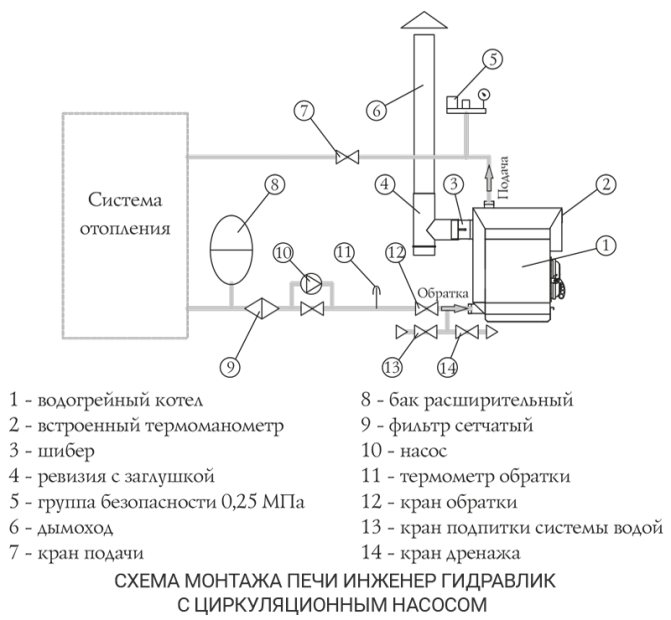

Location requirements
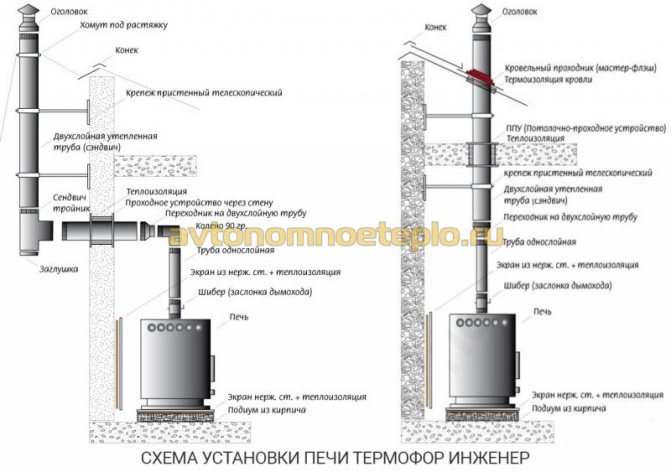

The special design and use of a special base simplifies the installation of the Engineer oven and makes it possible to do the connection yourself.
Which chimney is better
Solid fuel heating equipment belongs to the class of stoves with a high temperature of flue gases. During combustion, inside the combustion chamber, the heating intensity reaches 450-550 ° C. Although due to the use of gas generation, the smoke cools down significantly at the exit, the temperature still remains sufficient to lead to burnout and deformation of a conventional steel chimney.
Additional requirements apply to traction performance. Insufficient pressure leads to reverse thrust, air congestion and other difficulties in operation.
Feedback from the owners and practice have shown that the best choice for convection and hot water ovens is a sandwich pipe and a ceramic chimney. An additional plus of the systems is a simple self-installation of the chimney. Sandwich pipes and ceramics are assembled by the type of a constructor and do not require special skills for installation.
Reviews about furnaces Butakova Engineer
On the net you can find negative reviews about the furnaces Professor Butakov Engineer, but they are rather an exception to the rule. Basically, the owners point to the advantages of Termofor products:
- Affordable cost.
- Long service life.
- Simple design that allows self-installation of the stove in the house.
- Thermal efficiency, due to the ability to connect to a hot water heating system and air ducts.
All of these factors ensure the uninterrupted and comfortable operation of Butakov's Inzhener series furnaces and explain the popularity of the models among the Russian consumer.
Professor Butakov's simple stove: 3 features
Heating stoves Professor Butakov is a product line of the Termofor company.Butakov's heating stoves have earned their popularity due to a number of advantages. The numeral reviews of the owners praise the attractive appearance of the structure, good technical characteristics, affordable cost, and economy. Also, ovens are presented in a wide range.
Content:
All models of Butakov's stoves have an attractive appearance that suits any interior. Model range of Butakov stoves: Gymnasium student, Student, Engineer, Professor, Associate Professor. The varieties differ in power.
The development of Butakov's stoves resulted in practical, beautiful and very efficient heating stoves.
The Gymnaz student's power is 5 kW. This is the weakest stove. The power of the Professor is 40 kW.
The high school student is a heating and cooking stove. The upper part of the model is equipped with a hob. A chimney is installed immediately, which helps to save space. But this design lowers soot and condensation back into the furnace. At the same time, it is quite inconvenient to clean the chimney.
The most popular model is the Student. The diameter of the pipes is larger and the thickness is smaller. This increases the heat transfer. The flue exits at the rear of the body and is secured through a tee. So cleaning can be carried out without disconnecting the pipe. The tee has a traction control valve.
Varieties of furnace Butakov Student:
- Wood stove with a metal door;
- Coal version with a metal door;
- Furnace with a cast iron door with built-in glass.
The Engineer model is widely used for heating private houses, summer cottages, small industrial buildings. The design of the pipes resembles the Butakov Student's stove. The large diameter and small thickness make the model more efficient. Furnaces Professor and Associate Professor are considered the most powerful and are used for large rooms and industrial areas.
Furnace design by Professor Butakov Student
Butakov's stoves have earned their popularity due to their many advantages. So the structure heats up well, is powerful, economical and multifunctional. An interesting design allows you to use much less fuel for heating.
The Butakov Student stove is a medium-sized modification of the grate type, which is the most popular model in everyday life.
Scheme of Butakov's furnace:
- Ash pan - used to collect ash and other combustion products;
- Air exhaust pipe;
- Firebox for two chambers, the first chamber is connected to gas, and the second is used for afterburning;
- Chimney;
- The grate.
The pipes are located at the edges of the oven on both sides, then close and cross at the top. This allows you to warm up the floor in the room well. Also, pipes increase the heating area. At the top of the firebox there are special jets that completely burn out the gas. Such a system is quite economical. The maximum heat is given to the room, the fuel is used 100%.
The principle of operation of the air-heating boiler Butakov Professor and Student
The principle of operation is the action of pyrolysis and convection at the same time. Pyrolysis starts in the loading chamber. Here the fuel begins to smolder, not burn. Using the damper, you can regulate the degree of combustion by letting in oxygen. The released gas during combustion is transported to the second chamber, where it is finally burned.
Distinctive features of the Butakov hot-water boiler:
- The pipes in the system are mounted at a certain slope.It is important to comply with all parameters when setting up yourself.
- There is a convection chamber in the doors. It contributes to better heating of the premises.
- The oven is easy to use. The ash pan can be easily removed and cleaned. It is this oven that is considered the most efficient and economical.
Convection passage in specially installed pipes. Cold air enters the system through the lower pipes, and after passing all the way, it becomes hot and can warm the room. But such sudden temperature changes form condensation. But if you run a small branch pipe to drain the condensate, there will be no problems.
Cons and pros of professor Butakov's boiler Student
The Butakov stoves have a lot of advantages. The unique design of the device greatly simplifies the operation of the device. So the ash box does not require frequent cleaning, as it has an elongated shape. In addition, other advantages of the furnaces are distinguished by the Professor and the Student.
Stove Butakov Student is designed for cooking and heating the room up to 150 cubic meters
Advantages of hot water boilers:
- At the entrance there is a large distance from the floor of the convection pipes.
- Affordable cost. The invention is not new, therefore it does not require expensive materials and developments. For work you need cast iron and steel.
- The dimensions are small, but the oven is spacious.
- Structural strength. Thanks to the materials used, the oven is resistant to various adverse conditions.
- Multifunctionality. The upper part with the stove is used for heating water or cooking.
- The efficiency of the furnace allows you to heat large areas up to 1500m2.
- Any fuel can be used.
- Environmental friendliness.
- Fire safety.
The appearance of the stove is quite attractive. In addition, the simple installation of the device will please. It is fast and does not require any special skills. The hot water boiler is durable, but there is no need to take too much care of the device. Enough to clean up the ash in time.
Ash removal is quite simple. For this, a special compartment is provided in the oven. In this case, you can not wait for the fire to burn out.
But any design also has negative sides. Butakov's furnace with a steel casing may heat up too quickly. And this threatens with burns if you are not careful. When the oven is turned off, it cools down quickly.
Making Butakov's heating stove independently
First, you should study the boiler diagram. An air heating boiler is no different from the assembly of gas generator options. An ordinary metal barrel is taken as a basis.
The sequence of self-assembly of the furnace:
- The top of the barrel is cut off with a grinder. The edges are folded.
- A circle is cut from the steel sheet, the diameter of which is smaller than the barrel.
- Holes are made in the circle - 10 cm in diameter. Then a pipe is welded to it.
- The lower part of the pipe is equipped with channels. They must remain mobile. When burning, they press on the fuel, observing the combustion conditions.
- In the upper part of the pipe, a damper is mounted, the diameter of which corresponds to the diameter of the pipe. Drill a hole at the edge. The damper is screwed on. In the future, she will control the air supply.
- The edges of the cover are bent. Holes 10 cm in diameter are made in it.
- The pipe is welded to the pancake and taken out through the hole in the lid.
- A brick platform will serve as the basis for the oven.
- A chimney hole is fitted in the body. A chimney is welded on top.
- An ash pan is being made at the bottom. To do this, cut a hole and install the doors. The capacity is also installed there.
- The chimney is welded from below. A knee is installed to it, a furnace is connected, then the structure is fixed.
The basis for the furnace can be not only a barrel, but also any other metal container. So for these purposes a gas cylinder or a fire extinguisher is used.In this case, it is enough to simply remove the upper part of the device using a grinder.
How the oven works Professor Butakov (video)
The Butakov furnace has a simple but effective design. The lineup includes 5 boilers of different capacities. Each option has its own peculiarities of use.
teploclass.ru
Heating a house with an air-heating boiler: pros and cons
Air heating is the most ancient heating system for houses in Russia. The Russian stove is the real progenitor of hot water boilers (VK) and is still used in rural areas.
The next "historical" modification of the VK is a stove-stove, widely known in the terrible years of the October Revolution and already a more modern version, in the form of wood-burning fireplace heaters. In all these examples, the heat from fuel combustion was not spent efficiently, and most of it was simply wasted.
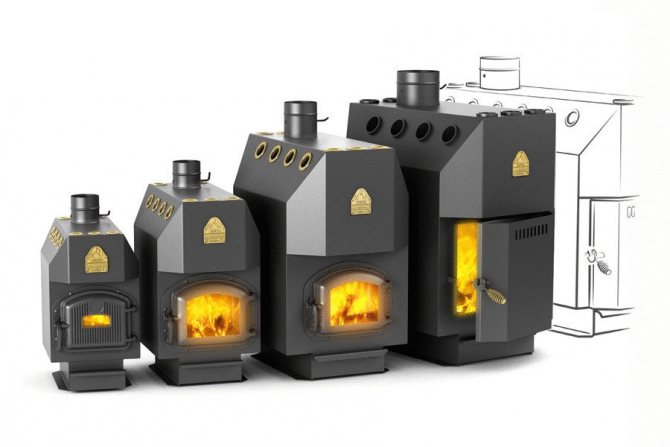

Modern long-burning hot water boilers have given new life to the technology of air heating of buildings. Today the devices modernized by Russian specialists have become competitive in the boiler-building industry.
A new generation hot water boiler appeared in 2002 in the Novosibirsk region. It was invented by a heating engineer E.Yu. Zubkevich and named after his relative Professor Butakov. Today, this design belongs to the class of energy efficient devices that reduce the cost of heating the home and emissions into the environment.
Pros and cons of hot water boilers
An air heating system is a complex of interacting devices and devices for transferring thermal energy released during fuel combustion to the surrounding space.
Modern VCs with a continuous burning system ensure continuous operation of the equipment without the presence of the owner or operating personnel.
The system no longer requires constant lighting and stopping of the furnace equipment, which saves fuel. The absence of batteries and piping systems reduces the overall metal consumption of the project and the costs of construction and installation work.
There are other advantages of VK:
- Low cost price.
- The system efficiency reaches 90%.
- The ability to install a duct system with the subsequent organization of air purification, for example, to fill it with silver ions, which is especially useful for allergy sufferers and asthma patients.
- Removing humidity in rooms.
- At elevated outdoor temperatures, the ducting can be used for the building air conditioning system.
- The absence of a water coolant protects the system from freezing, water hammer and other typical failures in the water network of coal-fired boilers.
- The boiler allows you to almost instantly heat up the air and has a simple integration into the ventilation system.
- Low cost of auxiliary equipment operating in the air heating circuit.
Despite its attractiveness, there are also "pitfalls" associated with air heating:
- The installation of the boiler and the air supply system can only be carried out at the facility under construction.
- The need for an additional power supply.
- To ensure high efficiency, the boiler is installed inside a room with a sufficient level of insulation.
Furnace device
Today, the most popular among consumers are air-heating boilers of Professor Butakov, which have a wide range of applications: private residential sector, garages, greenhouses, industrial warehouse and basements.
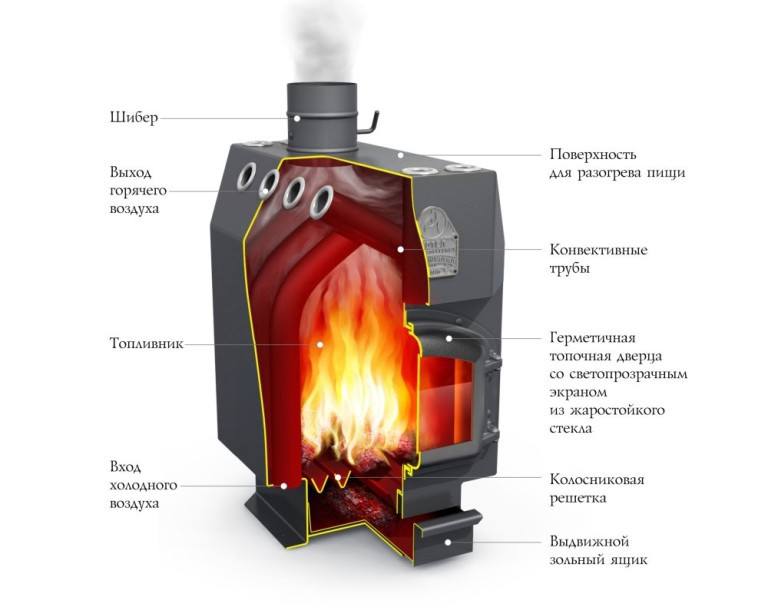

The main structural parts of a typical hot water boiler:
- Lower drawer for collecting ash and regulating the amount of air entering the furnace.
- A door with a handle located above the ash pan may have a heat-resistant glass window.
- The combustion chamber, its volume affects the amount of fuel loaded and the operating time.
- A cast-iron grate is located under the chamber. The sides of the chamber are closed by convection pipes crossing at the top.
- Chimney with a gate for adjusting the flue gas speed and draft intensity.
- In some VK models, an additional afterburner with two nozzles for oxygen supply is located at the top. It burns the gas that forms during smoldering.
A long-burning hot-water boiler is equipped with all the necessary automation devices, complete with temperature sensors and electronic control units. The automated fuel supply system and the increased volume of the combustion chamber allow the boiler to operate practically without the presence of a person.
Hot-water boiler on coal "Termofor Professor" with a cast-iron door
the coal industry in the post-Soviet space employs a huge number of people. Therefore, it is quite natural that in many regions of Russia and the CIS, the most popular household fuel is coal.
In addition, the calorific value of coal is several times higher than the calorific value of firewood.
Guided by the principle "better late than never", we have modified the popular PROFESSOR hot water boilers TERMOFOR to work not only on wood, but also on coal
| A sealed cast-iron door with a heat-resistant translucent screen allows you to visually monitor the coal combustion process. |
| The heat-resistant stainless steel screen absorbs the infrared radiation from the burning coal, protecting the boiler convection pipes. After the screen burns out, it is replaced with a similar one. |
| The new cast-iron grate normally operates at the temperature of free-burning coal. |
The gate is purchased additionally.
The range of long-burning solid fuel hot-water boilers with a rated power of 6 to 40 kW is designed for economical air heating of residential and non-residential premises with a maximum volume of 100 to 1000 m3, respectively.
The line includes the models "Gymnazist", "Student", "Engineer", "Associate Professor" and "Professor", united by a common principle of operation, layout and used fuel. They differ in overall dimensions, weight, volume of the combustion chamber, diameter and number of convective pipes, area of heating surfaces, as well as the diameter of the chimney outlet.
The boilers have a record-breaking surface area that is directly heated by a flame and cooled by air. Convective heat exchange tubes are directly in the flame along the entire cross-section and along the entire length, from start to finish. The front and rear surfaces, on which the convective pipes are placed, fully participate in convective heat transfer. A large sealed firebox allows you to effectively use the stove in the long burning mode. Hot water boilers are designed primarily for heating rooms, but food can also be cooked on the upper horizontal surface heated by a flame. Due to additionally installed heat removers, it is possible to direct hot air from the side convection pipes through the air ducts to adjacent rooms.
The external design of the stoves is made in anthracite color. Furnace modifications differ in their configuration: steel or cast-iron door with glass, chimney outlet upward or backward.
The range of solid fuel hot water boilers is ideal for air heating of residential premises, garages, greenhouses, hangars and so on.
ldshouse.ru
Model range of boilers by Professor Butakov
- High school student, heating and cooking model, weight 49 kg, heat load 8 W, heating area up to 60 m2, cost up to 6800 rubles.
- Student, for private housing construction, weight 57 kg, heat load 9 kW, heating area up to 150 m2, cost up to 13,900 rubles.
- Engineer, for one-story houses and small utility rooms, weight 75 kg, heat load 15 kW, heating area up to 250 m2, cost up to 17,700 rubles.
- Associate professor, for non-residential industrial premises, weight 143 kg, heat load 25 kW, allows heating an area up to 500 m2, cost up to 28,000 rubles.
- Professor, for large residential and non-residential buildings, weight 57 kg, heat load 40 kW, heating area up to 1000 m2, cost up to 32,000 rubles.
The principle of operation of an air heating boiler
Air heating boilers can be made with different design solutions, but their principle of operation is the same. In boilers of this type, air is heated from hot surfaces, which ensures continuous circulation of air flows in the room.
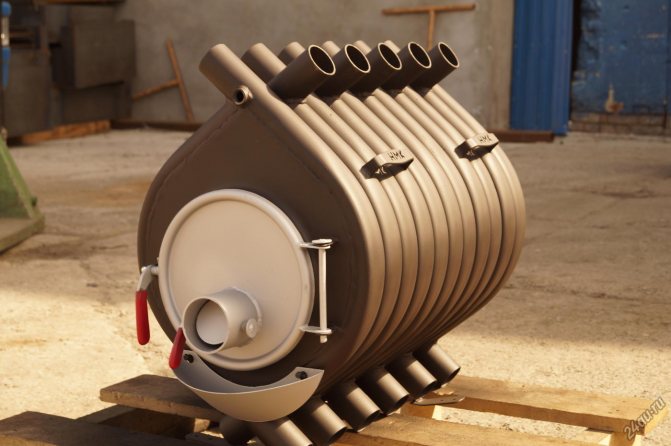

For efficient heating of adjacent rooms, a duct system is installed. If there are many rooms and the house has a complex, multi-level layout, forced ventilation is used to evenly distribute the heat flow and overcome frictional losses and along the length.
Modern VCs work on the principle of pyrolysis - a long process of smoldering firewood with a minimum supply of air in the combustion chamber, forming both gas and heat. The process takes place in two stages: ignition and gas generation.
When firing up, firewood or briquettes are placed in the firebox on the grate and ignited, while the gate and blower are left open. After the firewood is well heated, they are closed, thereby reducing the amount of air entering the firebox, and it is supplied only through the jets.
Secondary - represents a mixture of air and fuel combustion products. The fuel is not combusted completely, therefore, there are still flammable substances with a high temperature in the exhaust gases, therefore their "afterburning" is economically justified and will require additional costs. Secondary air is extracted from the upper part of the flue, and the volume and flow rate are adjusted manually or automatically using a damper, which is impossible in the old type of traditional boilers or furnaces.
Furnace Professor Butakov "Student": description, installation, operation
Collapse
Many residents of the country noticed that the supply of gas heating is a rather expensive pleasure. Since gas is too expensive, its use is not always justified. Therefore, firewood is a great alternative to heating a country house or a country cottage. Stoves "Student", made in various versions, belong to the most practical option for heating a house or garage. The most significant aspects include maintaining a balance between price, functionality and economy of models.
Device and principle of operation
The furnace of Professor Butakov "Student" has a rather simple design, it contains:
- two-chamber ash pan;
- firebox;
- air outlet pipes;
- grate bars;
- chimney;
- cast iron door with glass.
The principle of operation of the furnace used by the professor was known long before his development. Due to the low oxygen content in the furnaces, the fuel does not burn, but smolders slowly, releasing a sufficient amount of heat. This is what increases efficiency by eliminating additional bookmarks.
Furnace device "Student"
Characteristics
Considering that Butakov's "Student" oven has various modifications, their dimensions and technical characteristics differ significantly. The common feature of these devices is the presence of built-in convective channels used to increase heat transfer. Depending on the type, the stoves can work both for heating the air and providing water heating.
In this mini-review, we will look at stoves from.
This device is characterized by maximum thermal efficiency and high efficiency in comparison with coal analogues. It has the following features:
- Tightness of the combustion chamber - the door closes reliably, eliminating the formation of cracks.
- Improved control of air supply - the unique design of the gate damper allows you to set the modes of gas generation or just combustion.
- High-quality materials - thick-walled structural steel was used for the manufacture of the case, cast iron - for grates and doors.
In addition, the device is relatively small in size, which are:
- 530 * 780 * 370mm;
- chimney diameter 120 mm;
- the weight of the entire furnace is 77 kg;
- volume of the firebox 74 l;
- power reaches 9 kW;
- The efficiency is 85%.
The stove "Student" has an amazing ability to eliminate soot contamination of work surfaces. Even long-term use will not affect the cleanliness of the glass. The burning time allows you to make bookmarks no more than 1 time in 6-7 hours. The device is equipped with a replaceable grate that allows the air flow to be evenly distributed in the fuel chamber. This eliminates the formation of carbon deposits. The design of the ash drawer allows it to be cleaned without interrupting the combustion process.
Coal stove
When designing these heating furnaces, the intensity of the thermal load was taken into account. The device has the following characteristics:
- weight - 77 kg;
- furnace volume - 70 l;
- dimensions - 530 * 370 * 780 mm;
- Efficiency - 85%;
- Power - 9 kW.
Burning coal requires more oxygen than wood, but it generates significantly more heat. Due to the 5 mm wall thickness, metal deformation is excluded, which can provoke a quick breakdown of the furnace. The tightness and thoughtfulness of the design can significantly reduce the consumption of coal. A similar stove by Professor Butakov "Student", operating on coal, is an ideal option for systematic heating.
Hydraulics
Due to the unique design of the heat exchanger, the long-burning Student hot-water stove has a fairly high heat transfer. The usual coils in it were replaced by convective channels, partially recessed into the firebox. Thanks to these features, the liquid heats up intensively and enters the heating system. This large-sized device has the following characteristics:
- weight - 90 kg;
- power - 16 kW;
- firebox - 70 l;
- dimensions - 720 * 370 * 770 mm;
- The efficiency is 85%.
In addition, the design provides for the installation of heating elements, which allows you to maintain the temperature of the coolant for a long time.
Features of the device of the furnace "Student" Gidravlik
Attention! Electric heaters can be installed independently or purchased together with the boiler.
Advantages and disadvantages
The devices are distinguished by a whole list of advantages that are very valuable for products of this kind. Among them, it is worth highlighting the main aspects:
- quite convenient installation, which does not require certain skills and the construction of additional bases;
- quick ash removal, which can be done even at the moment of combustion;
- the design of the heating stove by professor butakov "Student" provides for an organic combination with any interior.
- large heating area;
- the presence of air cooling;
- sufficient size of the heating surface;
- functional firebox, equipped with air supply control, as well as combustion intensity;
- replaceable grates.
However, despite such a number of positive qualities, there were also some drawbacks. These include:
- strong surface heating;
- the need to wet the ash before removing it from the furnace;
- requires the use of reinforced thermal insulation for chimneys.
Nevertheless, the heating stove "Student" has much more advantages than disadvantages that do not affect the functionality of the device.
Installation and installation features
Considering that the surface of the device is very hot, the installation provides for enhanced thermal protection of floors and walls. This can be done in the following sequence:
- A basalt slab is laid on a wooden or other combustible floor, the surface of which should be sheathed with metal.
- Walls located close to the device are protected with basalt insulation. This will reduce the distance between the wall and the stove to 50 cm.
- The presence of supply and exhaust ventilation, both forced and natural, is unacceptable when installing the oven.
- When laying a chimney, you will need to protect the walls from heating. For this, a special fire-fighting cut and a spark arrester are installed.
If it is planned to heat adjacent rooms with heated air, it will be necessary to connect heat extractors and additional air ducts. The oven is installed in such a way as to facilitate the installation of the corrugated pipe.
Installation example
Another installation option (in the corner)
User's manual
It should be borne in mind that the stove for a dacha "Student" is a gas-generating equipment that makes special demands on the quality of the fuel used.
- It is recommended to use firewood, the moisture content of which does not exceed 25%, since the damp fuel will not allow switching the unit to the gas generation mode. This can provoke a decrease in efficiency with increased fuel consumption.
- For coal modifications, firewood is used as needed. To do this, you need to completely pull out the grates. When using wood or peat briquettes, the gap between the fillings is significantly increased. And also heat is generated by 28% more than from firewood.
Attention! It should be borne in mind that the design of wood modifications does not provide for the use of coal.
Buying Tips
In order for an ignorant user not to go nuts when buying a stove, it is necessary to know how the original product of Novosibirsk Termofor differs from a fake. Considering that the product is designed for long burning, high-quality material is used for its manufacture: thick steel for the body and durable cast iron for grates and doors. It is the design of the firebox door that is the main difference between the original and the fake.
Depending on the modification, the cost of the structure starts from 15,000, depending on the model. Considering the high functionality and efficiency of the devices, the price for the stove of Professor Butakov "Student" is quite adequate, which allows everyone to economically heat their country houses.
Output
The "Student" oven is a highly efficient convection oven. Due to this, cold air is taken from the room and thrown back in a heated state. The effectiveness of this technology has long been proven and successfully used. A distinctive feature of this model is the originality of design, efficiency, compactness and affordability.
pechnoy.guru
Installation standards
The conditions for installing the VK are simple, but for specialists, there are many nuances that you need to know so that the user is not disappointed in the choice of an air heating boiler.
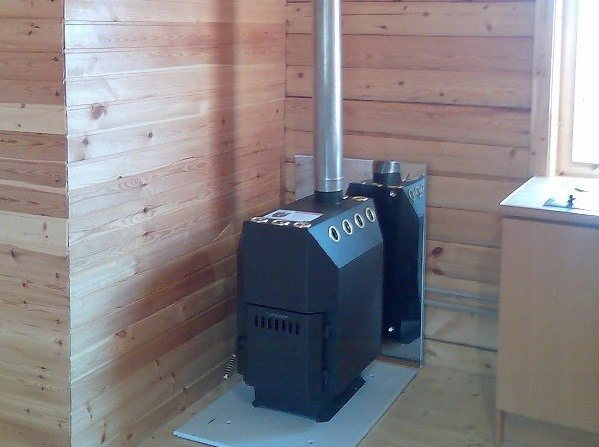

Features of VK installation:
- The boiler is installed indoors during the construction of the building.
- Specialists must first complete the installation project, taking into account the actual heating and structural characteristics of the building, in accordance with which the main and auxiliary equipment will be selected.
- The system must be equipped with a backup power source.
- To increase the efficiency, the boiler should be installed in a room with good thermal insulation of the walls.
- The furnace must have a good ventilation system for ventilation.
- Air ducts make sense if you are installing them in multi-level buildings over 100 m2.
To select a VC, the following data will be required:
- VC power, taking into account heat losses in the building;
- the rate at which heated air enters the room;
- technical data of the duct system;
- VK installation location.
If the installation of the boiler seems to consumers a difficult and impossible task, it is better to entrust it to a company that will carry out the entire set of installation and commissioning work for the heating system at home, in this case, you can avoid inconsistencies and ensure reliable and safe operation of the equipment for many years.
Installation
The installation of a hot water boiler is quite simple.First of all, you should choose a place for it. It shouldn't be too close to the wall. If the floor or wall is made of flammable materials, they are covered with non-flammable shields. On the floor, you can make a screed and put tiles.
A number of models are designed for wall installation between two rooms. They differ in that the convection pipes are led out in front and behind the body. They are mounted either during construction, or you will need to disassemble a brick wall, put up the apparatus, and then lay it back.
Before installation, the boiler is heated several times outside. If this is not done, during the first starts it will smoke due to the burning of the paint.
After choosing a place, the chimney is connected. A standard pipe is suitable for the diameter of your model. If you are installing a chimney in your home, the end of the chimney should be extended above the highest point on the roof.
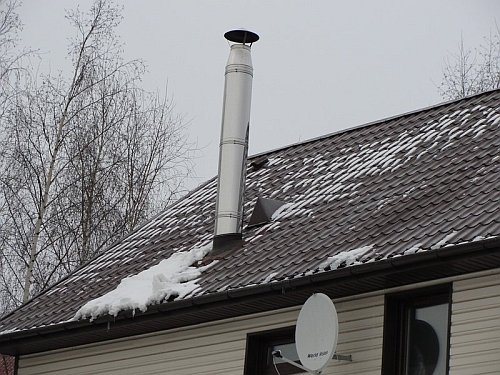

Chimney outlet
If wiring is required in several rooms, corrugation is additionally required. You can hide it under the ceiling by covering it with a box. It is connected to each other with reinforced tape or special tees.
Heating equipment for home
Information about air-heating heat generators, chimneys, calculation of heat output and choice of fuel.
Air heating boilers - is it worth it?
This type of heating will cost less than water heating.
In addition, the use of an air heating boiler excludes freezing, leaking and boiling of the coolant. After all, such a unit heats not the liquid, which is then distributed throughout the heating system, but directly the air. Thanks to natural convection, the room warms up much faster.
It is better to place small hot water boilers in the middle of the house so that heat is evenly distributed throughout all rooms. Then you get the effect of a Russian stove. Note that people with very limited financial resources buy similar low-power ovens in small houses and spend the winter quite happily.
Air heating is also justified in the case when heat is required sporadically. For example, in the country, in a hunting lodge, workshop, service station, garage, utility rooms.
In order to heat several isolated rooms or the second floor, it is necessary to provide heat supply to each room. For wiring equipment, it is necessary to purchase a heat sink, which is hung on the side of the boiler-boiler, and connect convective tubes to it. You will also need to make a hole in the room where the heat will flow, and bring an aluminum corrugated pipe to it.
But first of all, it is recommended to install the unit in its permanent place of "dislocation" and heat it up in order to identify in which rooms the heat will be insufficient. Only after that is it worth deciding where the wiring is needed.
There was a case when the owner of a rather large house installed an air-heating boiler in the bathroom and made the wiring to the rooms. But here you need to take into account that such a spider-heat generator with numerous branches from pipes and sleeves does not always look aesthetically pleasing.
In addition, it will also have to be heated and cleaned of combustion products (ash or slag) from the room.
It should be noted that not all models of this equipment involve a device for distributing heat flows. In this case, to supply heat to the second floor (for example, at a summer cottage during the off-season), sometimes it is enough to make additional ventilation holes.
For warmth and aesthetics
In recent years, one of the most common requirements among buyers is aesthetics. People want to see elements of antiquity in their interior, and heating boilers in the form of fireplaces with a glass screen are perfect for this.
You can, of course, buy a more economical simple version of the firebox, and after installation, decorate it with brickwork or special cladding.But here it is important to act not to the detriment of heat transfer.
Good heat transfer will be ensured only with proper equipment of convection holes for air circulation. Otherwise, the heat will go to a greater extent from the glass, and the heat from the furnace itself only after heating the facing material. Accordingly, the heated area of the room will be very small.
Finding a good fireplace master today is difficult, and the work will cost a lot. It is more profitable and less troublesome to purchase a ready-made fireplace, since it is provided with a sealed reliable glass and it is completely ready for use.
Determine the power
Traditionally, the boiler power is determined at the rate of 1 kW per 10 square meters (under optimal thermal insulation conditions and a ceiling height of no more than 3 meters). To ensure hot water supply when a double-circuit boiler is used, the additional power reserve must be at least 25%. In addition, manufacturers recommend that the main part of the time the unit works no more than 70% of its capacity (nominal, not maximum).
On average, a 13 kW model is sufficient for a 100 sq / m house without hot water supply. (10 kW + 30% of 10 kW as power reserve). To obtain more accurate data, it is necessary to take into account the climatic conditions of a particular region, the quality of the house insulation and the amount of heat for heating water.
It should be borne in mind that it does not make sense to install non-insulated boilers in a separate unheated stoker with walls in half a brick - you will simply heat the street. In this case, it is necessary to take a unit with basalt insulation between the casing and the walls. Long-burning boilers, as a rule, are all insulated.
What about the fuel?
When choosing boiler equipment, you need to take into account what type of fuel you plan to "heat up" with. For example, classic models of direct combustion can operate on any type of solid fuel - wood, coal, peat and wood briquettes, pellets. Coal is most often the most popular: when it is burned, more thermal energy is generated than from any other type of fuel, and there are no difficulties with the acquisition and storage.
Air heating boilers are traditionally fired with wood, but in addition to this, they are also capable of operating on lignite and hard coal, pellets and waste from the woodworking industry.
For the operation of long-burning solid fuel boilers, coal of the "nut" fraction - 20-70 mm is mainly used. With an optimized grate system, larger sizes are allowed. In terms of calorific value, pellets are comparable to natural gas and coal, but pellet boilers are fully automated and, therefore, volatile. In addition, such a "pleasure" costs more than 200 thousand rubles.
It will be somewhat cheaper to integrate a pellet burner into a conventional solid fuel (TT) boiler, since the cost of a high-quality imported burner is almost half. In terms of efficiency, pellets are comparable to gas. The main type of fuel for boiler-fireplaces is wood. Their design allows the use of pellets, peat briquettes and more.
There are few fireplaces and hot-water stoves that allow the use of coal. For example, the production unit has such a unit; the only “coal” model in the entire range is “Ognivo”. The instructions stipulate that this furnace assumes the use of coal as fuel. The metal from which it is made is much thicker compared to other models, and accordingly the weight is impressive - 120 kg. There are protective screens inside it.
There are other manufacturers who also allow the use of coal in some models of fireplaces, but, as they say, not aggressively.
The chimney is the most important thing
As mentioned above, a traditional brick chimney with wells is suitable for classic units.For long-burning boilers, an insulated straight chimney is required.
For such a chimney, sandwich pipes are usually used, which are not worth saving.
The thicker the insulation, the better. In order for the pipe to really work like a "sandwich", the thickness of the insulation must be at least 5 cm. In this case, the chimney heats up better, the draft is better, and less condensation is formed. Accordingly, less soot will stick.
Since the pipes are not sold entirely, but 0.5 or 1 meter each, when choosing it is important to note the tightness of the pipe connection, most reliably - a double tightness belt. Most reliable pipes and heat resistant chrome steel. It can withstand temperatures up to 750 degrees, that is, up to this temperature, the steel does not burn out, and while structural "black" steel, from which "homemade" is made, oxidizes already at 400.
Note: The burning temperature of wood reaches 700 degrees, and of coal - 900 degrees.
We add that in addition to the pipe itself, it will be necessary to purchase a head, clamps and sealant for the connection, tees (to be able to clean the chimney) and supports for fixing to the wall of the house.
The main difficulty in choosing a quality pipe is that the average buyer is unlikely to be able to distinguish low-quality steel from good. Therefore, the consultation of a specialist will be very useful in this matter. It will not be superfluous to pay attention to the label attached to the product - it must contain the steel marking and the barcode.
Principle of operation
When fuel is burned, heat is generated, which heats the air in the convection tubes. He rushes up, falls into the box and then is distributed throughout the premises. At the same time, the convective flow draws cold air into the pipe through the lower opening. It heats up, under the action of the Archimedean force begins to move upward, and the cycle repeats.
According to the method of fuel combustion, air heating boilers are divided into the following types:
- Direct burning.
- Pyrolysis.
- Forced air supply.
- Top burning.
- Pellet.
- Designed for the smoldering regime.
The first option is a classic "potbelly stove" with minor improvements.
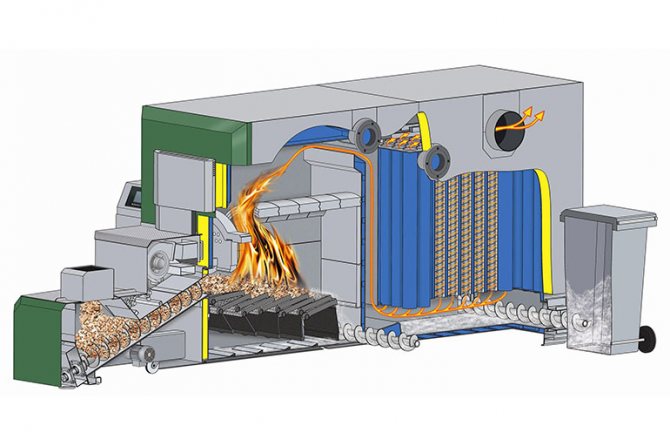

The principle of operation of a solid fuel boiler.
Its advantages are:
- simple construction;
- the possibility of non-volatile execution.
The device is considered to be of little practicality due to significant drawbacks:
- low efficiency;
- the need to frequently add firewood.
The firebox of a pyrolysis boiler consists of 2 parts. In one, firewood or coal under conditions of heating and lack of air decompose into flammable gases, in the other this mixture is burned.
Benefits:
- long-term operation on 1 fuel tab;
- high efficiency;
- minimum amount of ash;
- clean exhaust.
Disadvantages:
- impossibility of non-volatile execution (a strictly verified air supply controlled by an electronic controller is required);
- use only dry fuel.
The high cost of such devices should also be noted.
Forced air boilers are structurally similar to direct combustion heaters. The difference lies in the fact that oxygen is forced into the furnace by a fan, so at the right time, access to it can be blocked. Thus, the boiler operates in a "start-stop" mode: thanks to this scheme, firewood needs to be added less frequently.
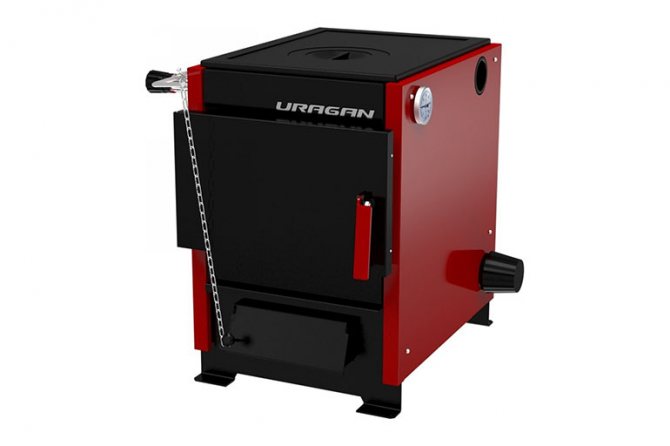

Air heating solid fuel units are efficient in operation.
Benefits:
- simple construction;
- low inertia.
The disadvantage is dependence on electricity.
In upper combustion boilers, the furnace is oriented vertically. There is no door at the front. The fuel is loaded from above, from the same side it is ignited. Air is supplied through a telescopic pipeline to the combustion zone.
The advantages of the scheme:
- long-term operation on 1 fuel tab;
- the possibility of non-volatile execution (for the wood-burning version).
Disadvantages:
- Ash sticks to the walls.
- A new portion is loaded only after the previous one has completely burned out.
The large sizes should also be noted.
This heat generator, as well as pyrolysis and forced air, due to its ability to work for a long time on 1 fuel fill, is called "long burning boilers". For some, the frequency of loading is 3 days.
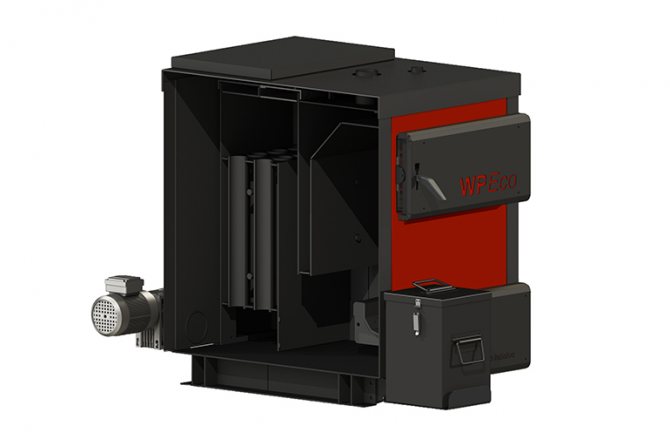

A pellet boiler is a type of solid fuel heating equipment.
Pellet boilers use as fuel granules of uniform size, made by pressing sawdust, cake and other organic waste. The material is fed into the furnace by a screw feeder from the hopper.
Benefits:
- relatively rare service;
- power regulation within wide limits (depends on the pellet feed rate);
- low inertia.
Disadvantages:
- volatility;
- lack of the ability to make fuel at home.
Boilers designed for the smoldering mode include devices of the brand "Professor Butakov", "Buleryan", etc.
Heaters combine 3 advantages:
- the ability to work for a long time on 1 fuel tab;
- energy independence;
- simple construction.
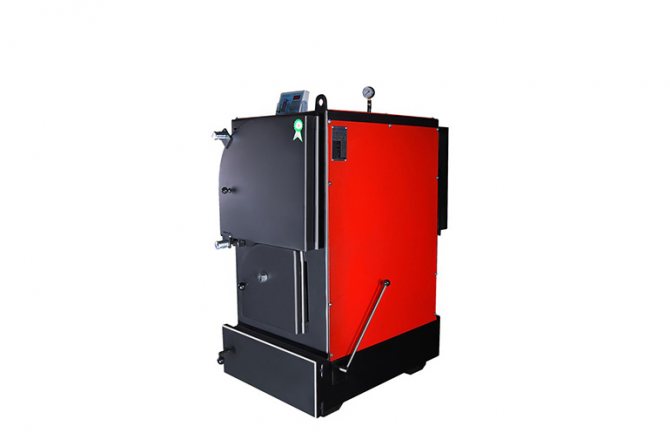

The heating structure can work in the smoldering mode.
This is an option for field conditions, when there is no power supply and, due to employment, it is not possible to often add firewood. With the help of a damper, the flow of air to the fuel is limited, and instead of burning it smolders, slowly giving off heat.
In some models, for example, the Buleryan brand, the chimney begins with the so-called. "Economizer". Its task is to block the thrust when the fuel is ignited (a gas lock is formed). This ensures the stability of the decay regime.
Fields of application: country house, garage, temporary cabins and industrial premises in areas with undeveloped infrastructure.
It is impractical to heat a comfortable dwelling with such a heat generator due to significant disadvantages:
- low efficiency;
- a lot of smoke;
- copious formation of condensation, which is a caustic acidic cocktail.
Appliances of this type are designed for low temperatures. Therefore, when burning fuel in them in the traditional way, they quickly burn out.
My personal rating of long burning heating stoves in 2013
Search posts by tags: just click on the topic of interest!
The beginning of the heating season.
The question will be raised more than once: "What is the best stove in the house?"
But I will take and make a rating of heating stoves, long burning, at my discretion!
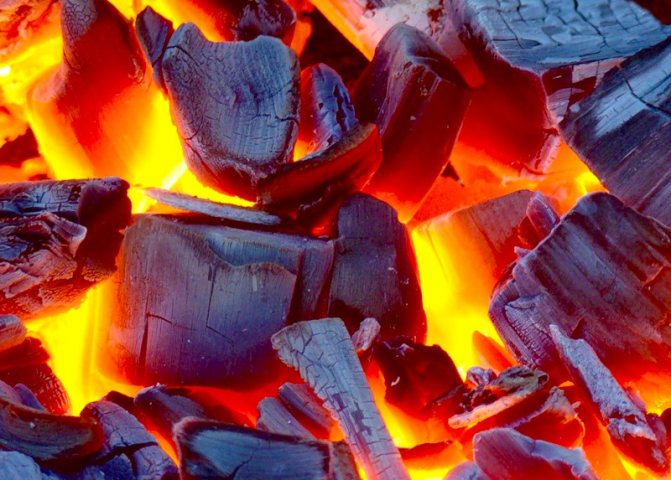

I’ll define it first. parameters by which I will select stoves (I will try impartially: I will mention both those that I sell and those that I do not sell)
I think the principles for selecting a stove for a summer residence should be as follows:
A) Reliability and fire safety of the structure, due to the factory manufacture of the furnace and the availability of the Quality Control Department at the plant
B) The duration of burning should be no less than 5 hours.
This means that the furnace must meet two criteria that give a long burning:
1) There must be jets (channels of afterburning gases inside the furnace), which allow you to obtain a mode of wood smoldering, with a closed supply of oxygen from other parts of the furnace (ash box, dampers of point air supply)
jets (afterburners) look like this (squares on the right or left on the walls of the furnace, the third channel is closed with a shiny plate):
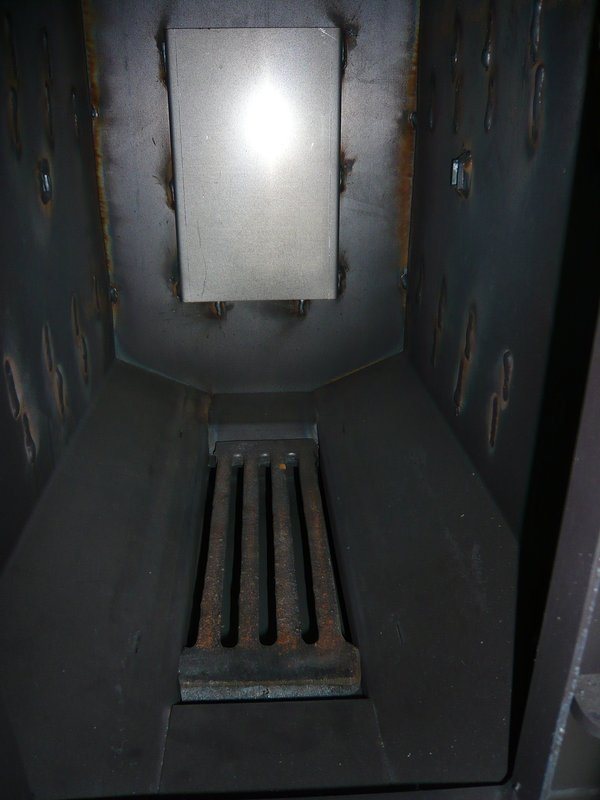

in the diagram, I showed the device of the afterburners: in this particular case, these are pipes welded to the firebox from the outside, through which air is supplied to the inside of the firebox, even when the furnace door is completely closed and the ash box is pushed in
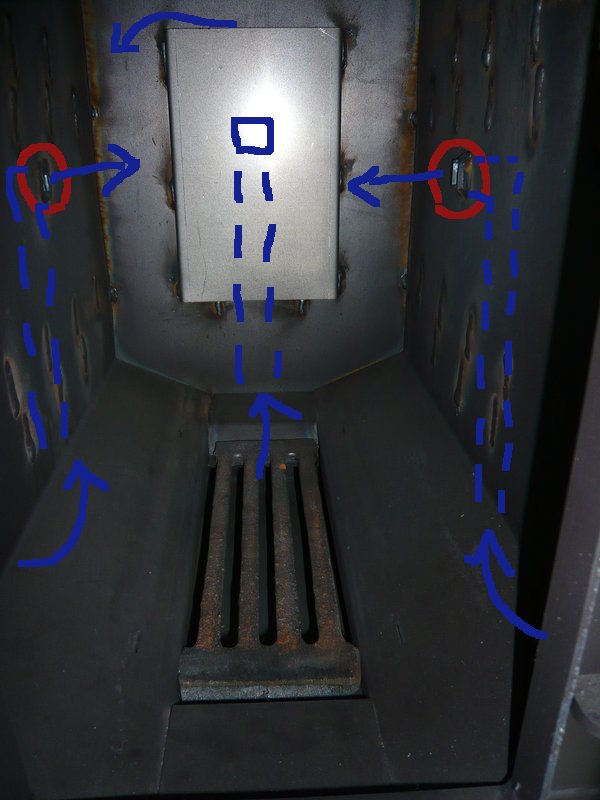

Afterburner channel close-up
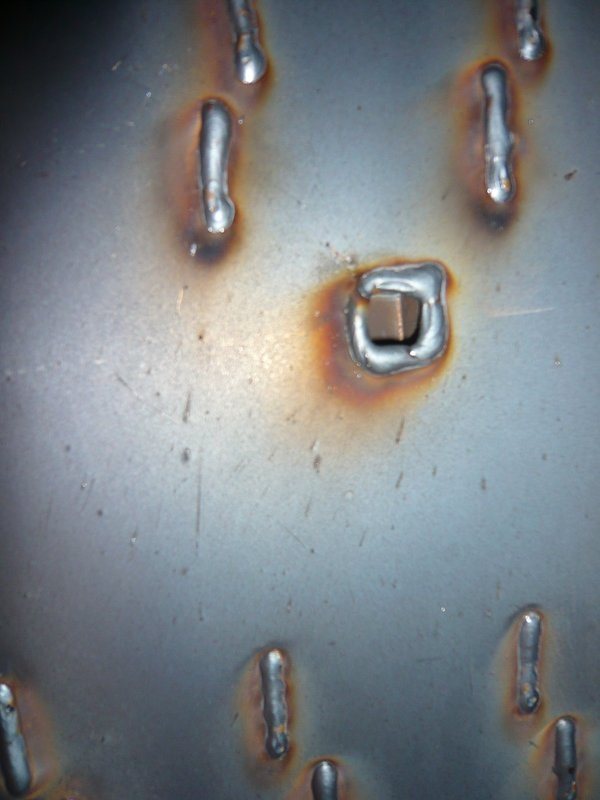

The jets themselves may not be visible during a cursory examination of the stove, they can be located anywhere in the furnace and are closed from the eye. The main thing is that they are.
Some manufacturers make jets at the bottom of the firebox, others, as in the photo, in the middle, others at the top of the firebox, and still others in the form of cracks in secret places.
Usually, the presence of jets is written in the instructions - this is a significant competitive advantage. If it is written in the passport of the furnace, it means that there are 100% jets.
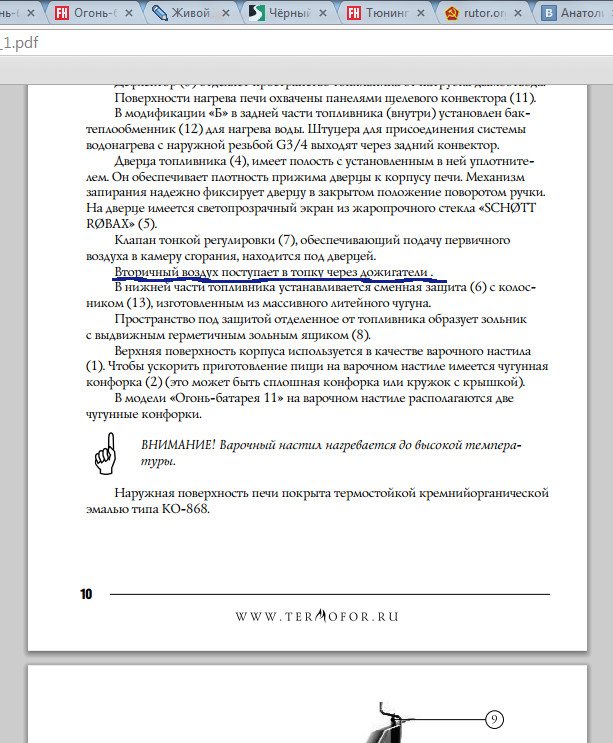

But sometimes they don't write
2) Large volume of the firebox + large opening of the firebox door = a large amount of firewood, pledged at the same time. This means that when choosing a stove, it is necessary to compare such parameters as "volume of the furnace" and "width + height of the door". It so happens that two stoves for the same cubic capacity of the heated room are arranged differently: one has a large firebox, and the other has a large door - the volume of firewood is the same as a result.
D) The presence of glass in the door. It seems, at first glance, a trifle, not essential, but during the operation of the stove, most people like to look at the fire. And it is a shame when there is a stove, but it does not come out to admire the fire, in the combustion mode.
E) The presence of a "tooth" (flame stopper), which "cuts off the flame", so that it does not enter the chimney, which means that the chimney serves for a long time.
This tooth looks like a plate / plates welded in the upper part of the firebox, covering the direct hit of the flame into the chimney
In the photo, the bumper plate is marked with a dash-dotted line
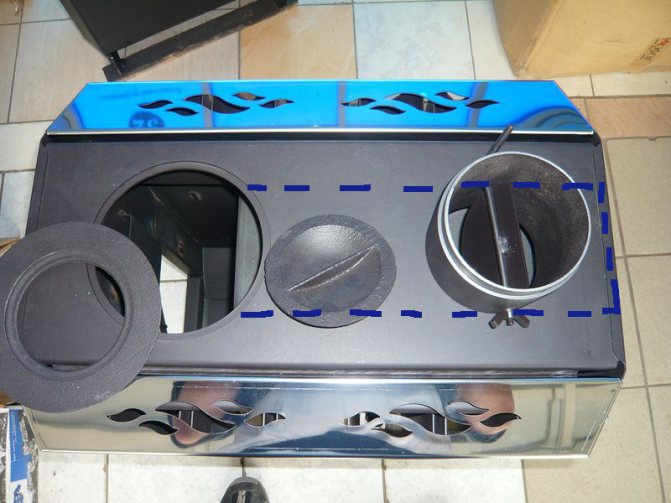

F) The presence of some design solutions that increase the service life of the furnace, in contrast to competitors that do not use these solutions, I will write about them separately, for those furnaces that use the offset from competitors.
So, after I have determined the required parameters, here it is, the rating of the best ovens in 2013:
III most honorable place
Breneran (nee buleryan)
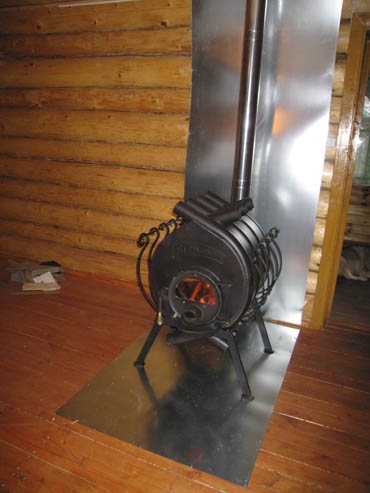

The oven is well-known, time-tested, fully meets all the criteria for an excellent oven.
Someone might say: the stove is morally obsolete
And I will object: it is like a car of the 20th century!
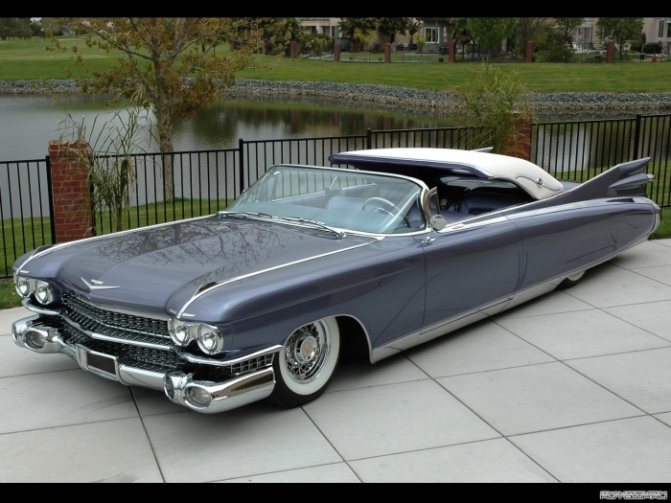

There are a bunch of different modifications, for any size, for any wallet.
There are only three downsides in my opinion:
- Controversial design
- Grateless combustion system (well, I don't like grizzly systems, they are demanding to dry firewood)
- A bunch of disgusting quality clones.
I will dwell on clones in more detail.
The fact is that making a clone of Buleryan is quite simple: you need a garage, a pipe bender and a welder, but the pipes will be welded inside the furnace. And since the system is grateless, the coal will be welded.
At the same time, it is not yet a fact that clones are cooked with good electrodes, high-discharge welders.
In short, if coal lies on the welds, they burn out and quickly enough.
Open the furnace firebox and see: if there is no welding inside - this is the original, you can take it, the furnace is excellent
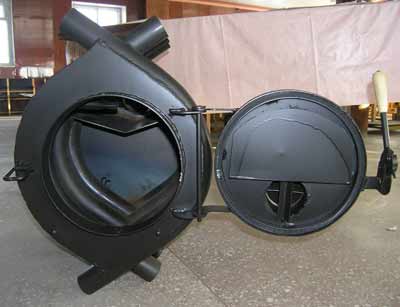

but if you see something like this (I took a specially grotesque photo to make it clear about the seams) - then to hell with it, no matter how attractive the price is
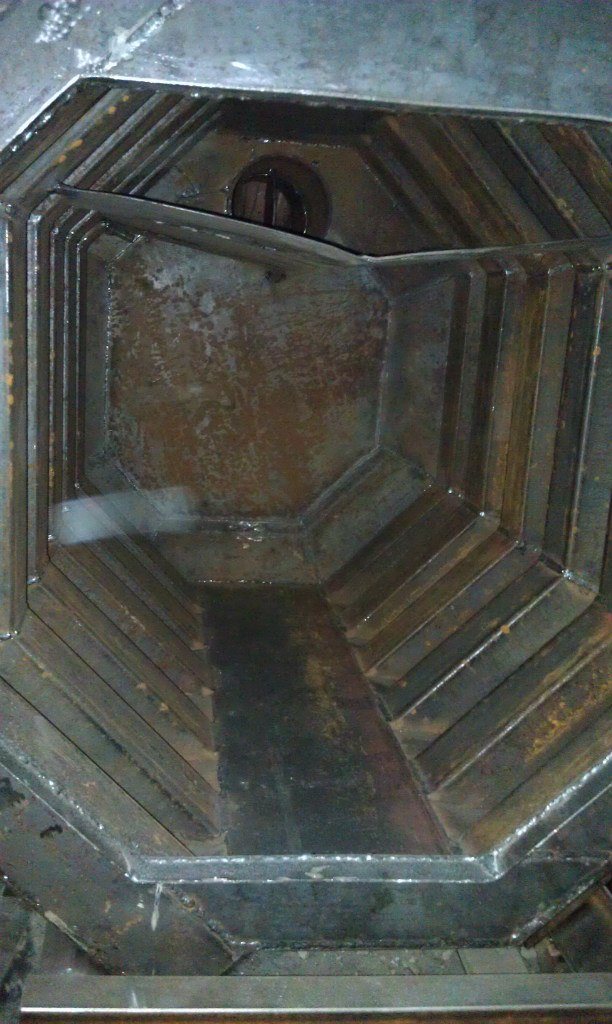

Here is a very good video review on Bulik
In short, this is what I think: almost all the negative about Buleryan on the Internet is negative about his clones, and not about the original.
If you buy, head into the firebox and look for seams.
There are seams - goodbye! no, thanks!
II place, even more honorable than III
Legion (nee PO) by Vira (nee "Burn it is clear")
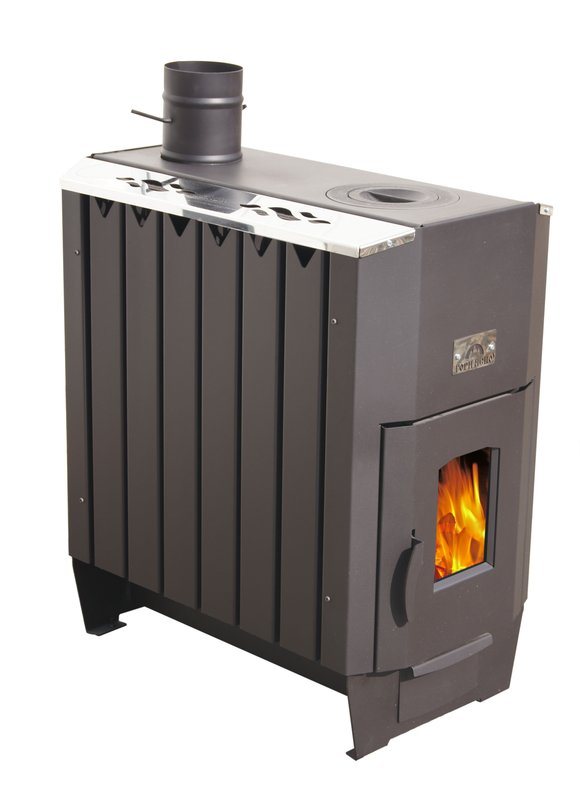

The stove is a technological clone of the Fire-Battery stove, but it has one significant plus and two significant minuses.
- the stove is much cheaper than the original Fire - Batteries
- cooked by people, not by a robot, unlike Fire-batari
- looks less simotically than Fire-battery, very, very similar to Butakov.
The most important thing is that the stove fully meets the criteria that I asked at the beginning, but its price is simply ridiculous, relative to competitors. This is due to the fact that the plant that produces it is young and at this stage of development "enters the market." Hence the price is low. Strategy, however.

